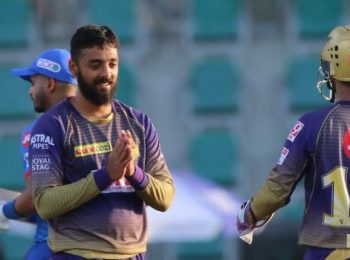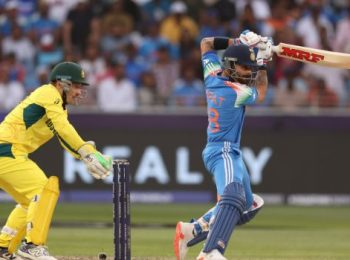Twice in the span of 24 hours, we have seen two matches in this year’s IPL break from pattern and allow the ball to dominate bat, resulting in two low-scoring matches not lacking in drama (and no, I am not referring to the brawl that ensued in Lucknow two nights ago when I say ‘drama’).
On Monday night at Lucknow’s Ekana Stadium, which in successive games has rolled out two pitches not conducive to easy run-scoring, Royal Challengers Bangalore posted 126 for 9 against the home team and then won by 18 runs. A day later, last-placed Delhi Capitals met defending champions and table-toppers Gujarat Titans in Ahmedabad and, after making 130 for 8 in their 20 overs, the visitors sealed an unexpected five-run win.
In both matches, hitting boundaries was a task and many wickets fell out of frustration when stroke-making batsmen started to find new ways to move on. Are these two low-scoring results, in which batting was tricky and the spinners had a field day, an aberration?
Let’s take a look at the bigger scenario. First of all, due to the surprising lack of dew this season, many teams have failed in their plan to chase and more are choosing to bat first. Second, as the IPL goes on, the tracks are expected to slow down and you can expect to see lower totals.
The season started with a glut of high-scoring matches, as you expected, with the odd low-scorer more indicative of poor batting than tough pitches. At the Ekana Stadium, Sunrisers Hyderabad were restricted to 121/8 and Lucknow Super Giants chased their target down with five wickets and four overs remaining. Nearly three weeks later, following a run of 16 matches in which 190 was crossed 10 times and on nine other occasions 170 was touched, Kolkata Knight Riders were bowled out for 127 at Delhi’s Arun Jaitley Stadium. The Capitals won, but they lost six wickets in doing so and the chase went to the last over. The next day, Hyderabad made 134/7 in Chennai and the home team won by seven wickets with eight deliveries left.
Then on April 22, something odd occurred. Lucknow Super Giants kept Gujarat to 135/6 but ended up botching a straightforward chase. Lucknow were at one stage well-placed for victory needing 31 runs from 36 balls with nine wickets left, and KL Rahul well past the 50-mark and fully embedded. But the captain proceeded to lose his marbles, a couple other batsmen came and went immediately, and Mohit Sharma bowled a final over that produced four wickets for just four runs to hand Gujarat victory by seven runs.
The following days saw totals of 214 and 201 in one match, the day after that 189 trumped 182, and right after that Chennai Super Kings racked up the season’s highest total of 235/4. Normal service restored? Well, these three matches were played at the Wankhede Stadium, M Chinnaswamy Stadium and Eden Gardens – the three easiest places to bat this year. The Wankhede, with its red soil pitch, has always been a fun place for batsmen. Bangalore’s Chinnaswamy, with its small boundaries and altitude, is a batsmen’s paradise. Eden Gardens, despite its larger dimensions, has been very profitable for batsmen and a struggle for most bowlers. No matter what strip you play on at these three venues, runs will flow.
This is not the same for Hyderabad, Delhi and, though the sample size is smaller, Jaipur. In Hyderabad so far this year, we’ve seen a high score of 203/5 and a low of 144/9. In Delhi, the highest has been 197/6 and the lowest 127. At Jaipur’s Sawai Mansingh Stadium, two matches have thrown up totals of 154/7, 144/6, 202/5 and 170/6. This has as much to do with the slowness of the tracks on certain days, as well as batting woes in several teams’ lineups.
Just when you wondered if that seven-run loss would scar Lucknow, six days later they came out blazing against Punjab Kings to score the second-highest total in the IPL ever, 257/5. The 200-mark was crossed four times in one day not long after, in what marked the first day in the IPL’s history that two matches had over 400 runs in each.
And then, as soon as May began, something else happened. An opening stand of 62 between Faf du Plessis (44) and Virat Kohli (31) proved the difference for RCB in a match in which the next best contribution was 23. The visitors struggled from the first delivery of the match, which was bowled by left-arm spinner Krunal Pandya and took Kohli’s edge to run away for four, but still defended 126.
It was a bizarre match, because the batsmen just could not consistently find the boundary. Spin accounted for eight wickets, pace for seven and there were two run outs. How Lucknow failed to chase 127, even with Rahul injured, was head-scratching. Had the tricky Ekana Stadium pitch reduced run-scoring to such a task?
Yes, and no. Some deliveries stopped on the batsmen, some sat up to surprise a few, but overall it was the slowness of the pitch that had the batsmen trying to find a happy medium between going hard and nudging singles. You get the feeling that Lucknow surely did not want such a track, but that this is going to repeat itself at that venue.
The result in Ahmedabad on Tuesday night was more surprising, because the ground had generally been favourable to batting. When Mohammed Shami’s incisive pace accounted for four wickets inside the Powerplay and reduced Delhi to 23/5 after five overs, you got the sense that this was just another woeful batting performance from the bottom-placed team. From there, to get to 130/8 was a solid effort, but with Gujarat’s chasing pedigree it looked like an easy job for the hosts.
Instead, Delhi sliced up Gujarat to 32/4 in the seventh over and Hardik Pandya, despite batting 53 balls for 59 unbeaten runs, failed to finish the chase. Rahul Tewatia’s three successive sixes off Anrich Nortje boosted Gujarat, but in the end it came down to an ice-cool final over from Ishant Sharma to bowl Delhi to a vital, and unprecedented, victory. Pandya took “full ownership” for this loss, which is just the third for Gujarat, and it was indeed strange to see such batsmen reduced to second-guessing and unlikely shots on that track, particularly David Miller walking across the stumps to try and paddle Kuldeep Yadav.
It is almost as if batsmen in this IPL are starting to freak out the moment they realise that runs are not going to come easily on such tracks. What this does is, refreshingly, bring the spinners into play and make for some absorbing viewing. This is not bad for viewers wanting to see some wickets fall, but overall it doesn’t augur well for the broadcasters and the league stakeholders.
With a little over three weeks left in the IPL, we can expect to see drier tracks and lower totals. Which is not a bad thing, for it will force captains and teams to readjust their plans. And a bit of unpredictability is what you want in a tournament as engaging as the IPL.



























